
First Saints Ticket Sold
March
8, 1967
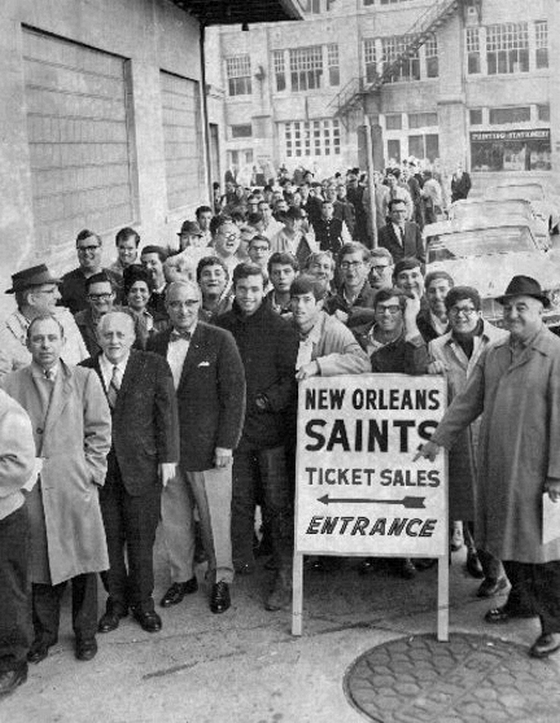
Twenty-seven year-old Calvin Long, a baker from Poydras,
Louisiana, earned a place in Saints history when he purchased the first franchise season ticket on Wednesday, March 8, 1967.
Al Whiteman, a Kenner flashbulb salesman, bought the second. Tulane students Ron Nestor and Charles Mendez camped outside
of the Mecom Building, 944 St. Charles Ave., on Lee Circle next to the YMCA at 9 p.m. the night before. But they waited
at the wrong entrance and lost their bid for the first set of tickets. Many others had arrived on Tuesday evening to
mark their spots in line.
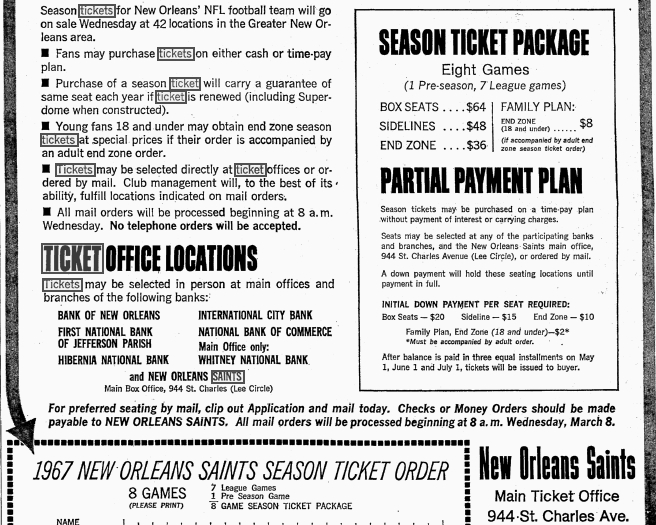
Ticket Manager Henry Simoneaux was prepared with a staff of 28 -- twenty women had been hired to work during what
was expected to be the first weeks' rush. Saints owner and president John W. Mecom Jr. worked at the ticket counter all day,
beginning at 8 a.m when the sale began. By 8:30, several hundred people were in a line which stretched down St. Charles
to Howard Avenue and on the Camp Street. By 9:00 a.m., Simoneaux calculated that approximately 20,000 tickets had been sold
-- a new NFL first-day record. Almost $1 million worth of tickets were sold during that nine hour day.
Tickets were also available at 48 local banking outlets via a partial payment plan which allowed for no-interest
or fees with three installments due May 1, June 1, and July 1. Mail order tickets were also available on that first
day of sales. The 1967 season ticket package included seven home games and the pre-season exhibition game against Atlanta.
Box seats went for $64, sideline seats for $48, end zone spots for $36, and end zone family plan (under age 18 accompanied
by a parent) for $8. The majority of tickets sold on the first day were sideline seats.
Mecom said, "The people of New Orleans have been wanting professional football for more than five years.
Today they had the chance to express themselves, and , by golly, it looks like they've expressed themselves well".
The Saints had sold more tickets on that day than the Dallas Cowboys sold during the entire 1966 season (15, 500) according
to Times-Picayune sports editor Bob Roesler. By the close of business on Saturday, 25,000 season tickets had been sold,
and on March 20 sales reached 30,000.
Mecom stated that 1967 season
ticket holders would have a lifetime priority to keep the same seat, even after the move to the proposed domed stadium, as
long as they continued to purchase season tickets each year. He also announced the official team colors of black and
gold, stating that the uniforms would resemble those of Vanderbilt, Georgia Tech, and Army.
In other Saints news of March 8, 1967, Coach Tom Fears denied an AP dispatch printed in the Atlanta Journal
which stated that the Saints were willing to pay Green Bay fullback Jim Taylor $90,000 to play for the Saints the following
season. Fears stated that he never talked with Taylor, who would be a free agent on May 1, about playing for the
Saints.
Photos from the Times-Picayune
You Can Support this Site by Clicking on & Shopping from this Amazon Link -- and it
won't cost you a penny more:


On March 8, 2011, MSY was one of eight cities given approval for charter flights to
Cuba. Flights to Cuba have been scheduled on a very limited basis, with the first departure on March 26, 2012, operated by
Sky King, Inc., charters and marketed by Cuba Travel USA.
The Hornets played their first game, since the start of the 2005-06 season (post-Katrina), at the arena
on March 8, 2006, to a sellout crowd of 17,744, as the Los Angeles Lakers defeated the Hornets, 113–107.
The first Time-Saver store opened on
Monday, March 8, 1954 at 1201 South Carrollton Avenue at Oak Street. It
offered a unique service -- motorists could drive INTO the store and park at display counters.
Stressing quicker service, the store sold "staple and unusual products". Its
exterior signs advertised groceries, ice, beer, and milk. It was open from 7 a.m. to 11 p.m. By 1964 there were
Time-Saver stores in 15 locations in the greater New Orleans area. By 1986, there were more
than 100. The first location of Time-Saver is now a Fidelity Bank location.
Henry E. Chambers, educator, historian. Born, New Orleans, March 28, 1860, son
of Joseph Chambers and Maria Charles. Education: public and private schools, New Orleans; Tulane University; Johns Hopkins
University, Ph. D. Married Ellen White Taylor of Crystal Springs, Miss., 1883. Children: John Taylor and Henry Edward,
Jr. Teacher in rural schools of Arkansas, superintendent of Beaumont, Tex., schools; principal and teacher, New Orleans
public schools; assistant professor of Science, Tulane University; principal and teacher, Monroe public schools, 1877-1901.
Editor of Progressive Teacher; founder and editor, 1893-1894 Louisiana School Review. Head of Louisiana State Chautauqua;
member State Teachers' Institute, and National Education Association. Founded Chambers Agency, Inc. (1905-1912); with LaVallière
Company, 1914 until death. Author of Constitutional History of Hawaii (1896), West Florida (1898), Mississippi Valley Beginnings
(1922), History of Louisiana, State and People (1925), and a history of the United States which was set in Braille. Member:
New Orleans Chess Club, University Club, Louisiana Historical Society, Mississippi Valley Historical Association, and American
Historical Association Died of stroke, New Orleans, March 8, 1929 Source: http://lahistory.org/site20.php
Born in Natchez, Mississippi on October 19, 1842, Adolph Meyer was a member of the Louisiana U. S.
House of Representatives who served nine terms as a Democrat from 1891 until his death in office on March
8, 1908. During the Civil War, Meyer served on the staff of Brigadier General John Stuart Williams of Kentucky
and attained the rank of assistant adjutant general. General Meyer Avenue in Algiers part of is named in his honor as a tribute
to his efforts to lobbying for the U.S. Naval Station which was located there.
Poet and historian Marcus Bruce Christian, born in Mechanicsville, Louisiana on March 8, 1900,
lived in New Orleans from 1919 to 1976. He joined the Federal Writers' Project (FWP) in 1936 and worked under its director
Lyle Saxon. He was assigned to the "Colored Project" at Dillard University and eventually became its director until
its demise in 1943, working with Horace Mann Bond, Arna Bontemps, Elizabeth Catlett, St. Clair Drake, Octave Lilly, Jr.,
Rudolphe Moses, Benjamin Quarles, Lawrence Reddick, and Margaret Walker. Under Christian's direction, the Dillard
project provided information on black Louisianians that became part of the Federal Writers' Project publications, The New
Orleans City Guide (1938) and Louisiana: A Guide to the State (1941). Much of this research also found its way
into a book edited by Lyle Saxon, Gumbo Ya-Ya (1945). The major work of the Dillard project, "A Black History of
Louisiana," was never published but was partially revised by Christian and donated to the University of New Orleans,
Archives Division. He was the assistant librarian at Dillard University from 1944 to 1950, a special lecturer and
writer-in-residence at the University of New Orleans (1969-1976). He was a contributor to From the Deep South, edited
by Christian (1937), The Poetry of the Negro, edited by Arna Bontemps (1949), and The Negro Caravan, edited by Sterling
Brown (1941). Christian was the author of (History) Negro Soldiers in the Battle of New Orleans (1955), Negro Ironworkers
of Louisiana, 1718-1900 (1972), amd articles in Negro History Bulletin, Phylon, Louisiana Weekly, and Dictionary of Negro
American Biography. His poetry volumes include In Memoriam—Franklin Delano Roosevelt (1945), Common Peoples'
Manifesto of World War II (1948), High Ground (1958), I Am New Orleans (1968; 1976), and individual
poems in Crisis, Louisiana Weekly, Phylon, Pittsburgh Courier, and New York Herald Tribune .
He died in New Orleans on November 21, 1976. Source: http://lahistory.org/site20.php
Operations at the New Orleans Mint began on March 8, 1838, with the deposit
of the first Mexican gold bullion. The first coins, 30 dimes, were struck on May 7.
On March 8, 1836 a new charter divided the city into three municipalities, each with its own board
of alderman, but under one mayor and one General Council represented by members of the three Municipal Councils.
Lenfants, Time-Saver, K&B, Dixiana Bakery, and Sciambra's
56 Years Ago Today
In the news November 27, 1957, The Mississippi River Bridge Authority accepted a $74,850.00 bid
submitted by R. B. Tyler Company of New Orleans which
covers the cost of materials and work for the East-West Bank bridge (now the Crescent City Connection)
presently under construction. The work includes using a special Bituminous Concrete paving
to be laid in the 24 and 28 foot wide span. This roadway will cover the steel grid flooring
between Pier No. 1 and Pier No. 3 of the 52 foot-wide roadway of the manin span. The bridge will have
two 12-foot traffic lanes in each direction. The only other bid for
this project was submitted by Texas Bitulithic Company.
State
spending was escalating as was its income (unusual for today). The skys were cloudy but the weather was typically mild
for this time of year. Bit it's the ads that make this page of the Picayune so wonderful for us now. None of these
popular businesses still exist.
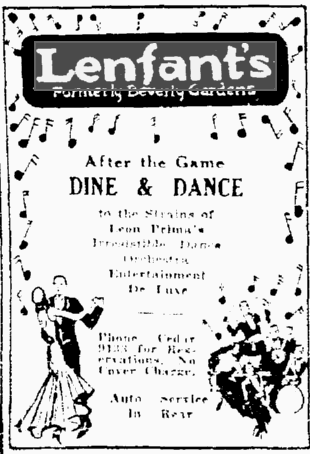
Lenfant's was offering a Thanksgiving Day (all day) dinner menu in 1957 with Broiled Choice Prime Rib Steak with French fries,
an appetizer, soup, vegetable, and dessert being the most expensive choice at $2.25. The Shrimp Lenfant, and Crabmeat
a la Ritz sound devine.
John L. Lenfant
was an entrepreneur who started out as a barber in the Faubourg Marigney who had a grocery and bar on Elysian Fields at Villere
Street. He was a sparring partner of boxer Jake Kilrain. Then he had a drugstore and a nightclub at St. Claude
and Elysian Fields which featured an open-air dance garden. He owned the Elysian Fields Theater back in vaudeville days.
He owned Eclipse Bottling Works, makers of Whistle soda and Glean cola -- both jumbo-sized drinks. He brewed beer for
Joe Brown's nightclub, during prohibition, on the 2nd of a building at Canal and Carondelet. He bought and sold real
estate. He even owned hearses which he'd rent to funeral homes.
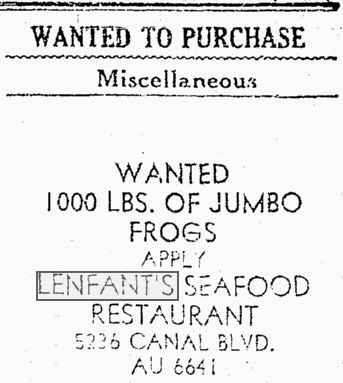
Then he got into the restaurant business. He opened several popular Rosedale Inn sit-down and drive-in restaurants
around town. Some locations including one at 1915 Canal Street, one at 5236 Canal Boulevard, one at 5205 Canal Boulevard,
and another at South Claiborne and Jackson Avenue. During the 1930s he owned Lenfant's on Metairie Road at the former
location of his Beverly Gardens gambling house. Leon Prima and his Orchestra (were playing there on
October
17, 1930 (Louis played there, too) and auto service via car-hops was available in the rear. When John Lenfant retired
he left the businesses to his sons.
Lenfant's
Sea Food Restaurant at 5236 Canal Boulevard opened in 1941. Diners could eat inside
the Streamline Moderne dining rooms or drive up to the huge shell parking lot where car-hops filled the bill. An interesting
item from those years is an August 22, 1942 want-ad for 1000 pounds of jumbo frog legs. Many New Orleanians
celebrated weddings and bridal and baby showers at Lenfant's. Many clubs regularly met there. The adjoining Boulevard
Room was well known locally. The building was demolished during the early 1990s and was replaced with Greenwood Funeral
Home (which John Lenfant might have rented hearses to if her were still alive).
Dixiana Bakery, at 2631 Bruxelles, on the corner of Broad Street opened in 1910 at the home of Dalile Rousseve
and his wife Jeanne Becnel. Dixiana was most famous for its Sarah Bernhardt Cake -- a rich wine cake with nuts, a red apple
jelly glaze and whipped cream -- "Looks just like a king's crown", read the advertisement. One could be had
in 1957 for $1.25. Cocktail sized pattie shells (for making oyster patties) were only 45 cents per dozen, and a fruit
cake would set you back $1.25. Dixiana copyrighted their famous "Melt-O-Way" products. Dixiana goodies could
also be found in the Schwegmann Airline Highway location. After a modernization and remodelling of the building, Dixiana
held a grand reopening on Saturday,
March 25, 1950. In the final years it officially became Klotzback-Dixiana
Bakery, Inc. but everyone still referred it (even today) as simply "Dixiana". It closed during the 1980s.
Recipe for Dixiana's Sarah Bernhardt Cake.
The first Time-Saver store opened on Monday, March
8, 1954 at 1201 South Carrollton Avenue at Oak Street. It offered a unique service -- motorists could drive
INTO the store and park at display counters. Stressing quicker service, the store sold "staple and unusual products".
Its exterior signs advertised groceries, ice, beer, and milk. It was open from 7 a.m. to 11 p.m. By 1964 there were
Time-Saver stores in 15 locations in the greater New Orleans area. By 1986, there were more than 100. The first
location of Time-Saver is now a Fidelity Bank location.
Jake Sciambra
had two restaurants with bars, one at 3201 Tulane and the one advertised here at 452 South Jefferson Davis Parkway, which
was also he and his wife, Lena Gallo's, residence. After running this place for some 30 years, Jake passed away
on April 8, 1970 at age 77. He was a native Contessa Entallina, Sicily and is buried in Greenwood Cemetery.
Gustave Katz and Sydney Besthoff opened their first drug store in 1905 at
732 Canal Street. Ninety-two years laster the company had grown to include 186 stores in six states. It was sold
to Rite Aid in 1997. For a history of of the company, read
K&B Drug Stores by John S. Epstein.









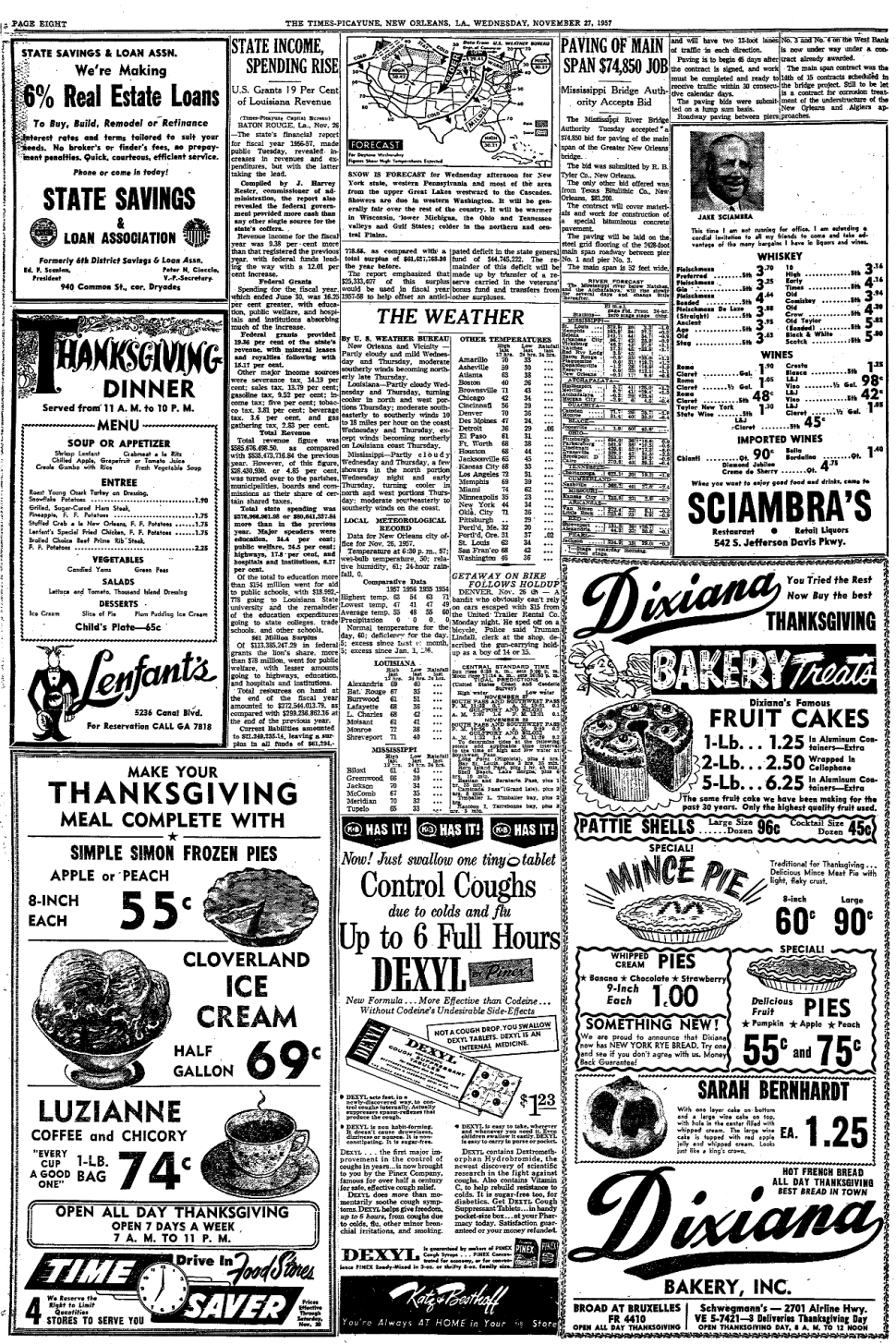
 Lenfant's was offering a Thanksgiving Day (all day) dinner menu in 1957 with Broiled Choice Prime Rib Steak with French fries,
an appetizer, soup, vegetable, and dessert being the most expensive choice at $2.25. The Shrimp Lenfant, and Crabmeat
a la Ritz sound devine.
Lenfant's was offering a Thanksgiving Day (all day) dinner menu in 1957 with Broiled Choice Prime Rib Steak with French fries,
an appetizer, soup, vegetable, and dessert being the most expensive choice at $2.25. The Shrimp Lenfant, and Crabmeat
a la Ritz sound devine. 

